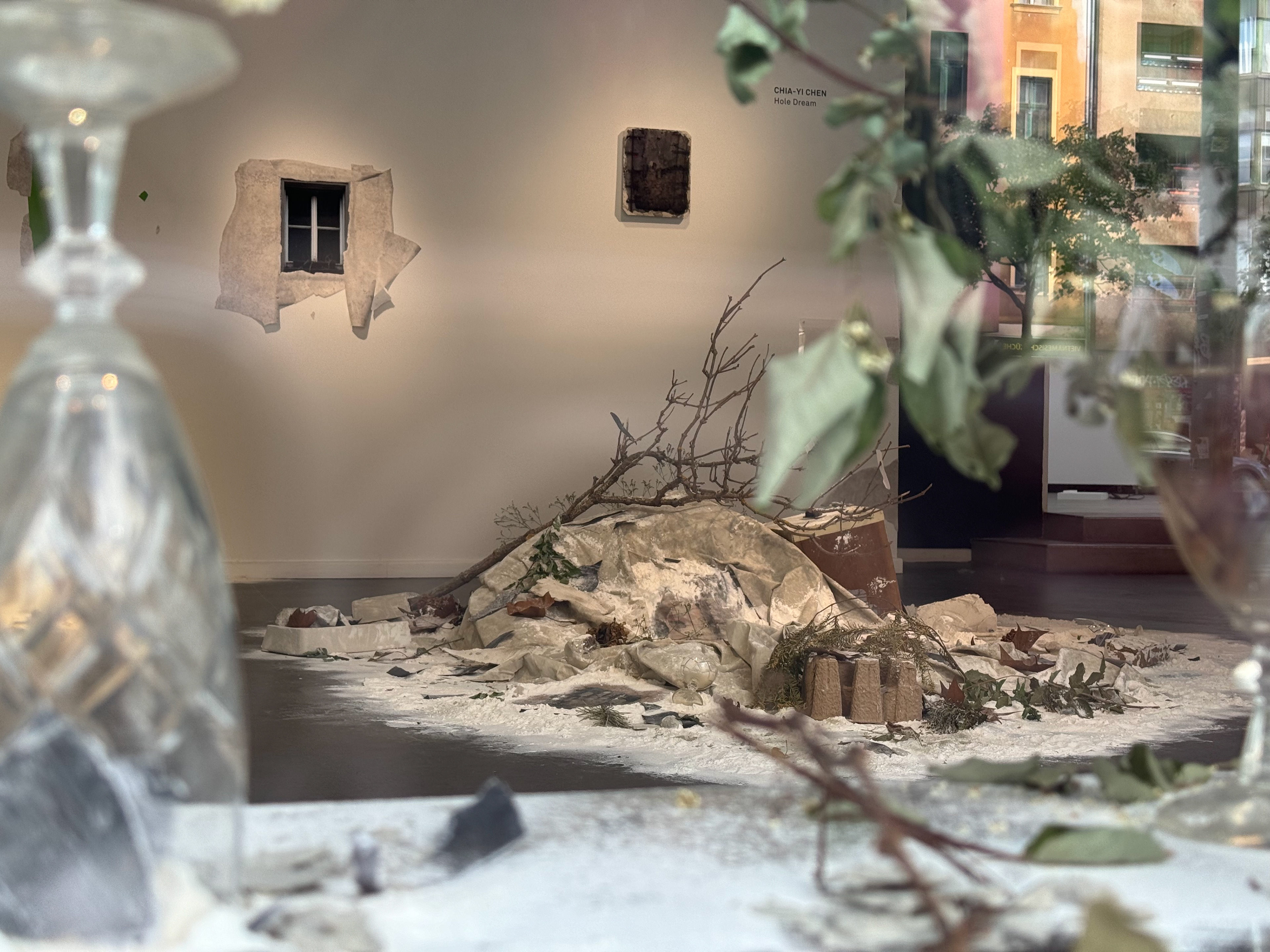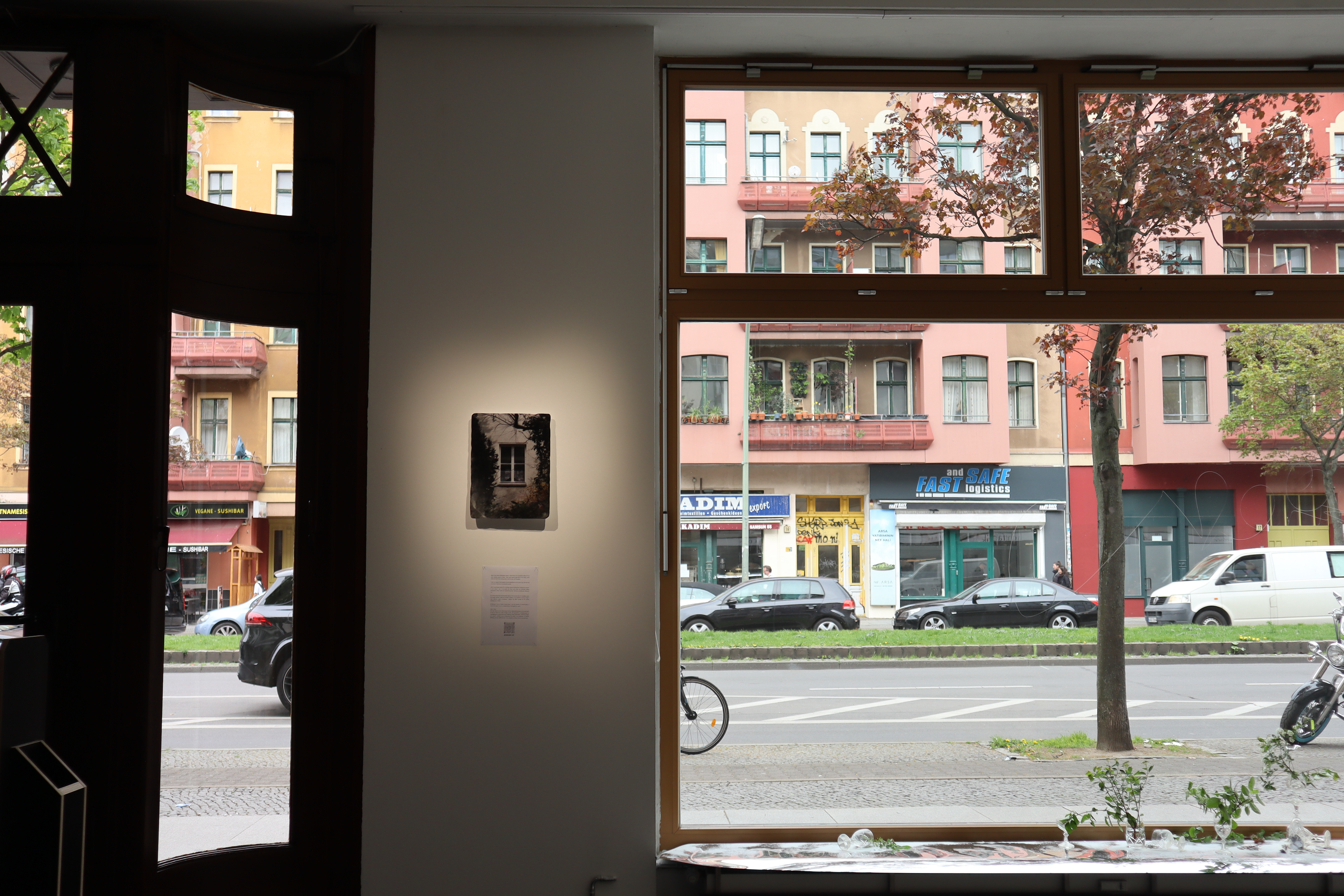方志軒/撰寫(創作陪伴觀察員)
洞(hole)一字除了表示著兩個物理空間之間的細縫外,在哲學意涵中也隱喻著柏拉圖所提之「洞穴之喻」的想像,其泛指對於說明人類因感官經驗而受限於錯誤的表象。然而,在將洞符號化後,再透過不可見事物的視覺化與理解其視域(Horizon)的範圍之後,場域的生活路徑將被顯化。
The concept of a hole extends beyond its physical manifestation as a fissure between spaces.Philosophically, it echoes Plato’s Allegory of the Cave, symbolizing humanity’s constrained perception— a shadowy representation of reality shaped by sensory limitations. When visualized and semiotized, the hole becomes a gateway to the unseen, revealing the latent possibilities of its horizon and the unfolding narrative of its environment.
《洞夢》(Hole Dream)展覽係由藝術家陳家翊以自身生長在台北與駐村於柏林期間所累積的兩地生活差異經驗,作為創作藍本。
In Hole Dream, artist Chen, Chia-Yi draws from her lived experiences in Taipei and Berlin, weaving the contrasts between these two cities into her creative tapestry. During the second phase2 of her residency project, presented in Taiwan, Chen reimagines Berlin’s architectural impressions and integrates them with Taiwan and Japan’s historical and cultural narratives.
在本次個展中,將呈現駐村計畫發表的第二階段,作品重新延伸和形塑,並將柏林的印象介入澍林藝廊的歷史記憶。呈現方式運用了在柏林所搜集的破洞影像與德國工業風格的窗景影像,結合展示空間本身具日治時代特色的木造建築環境,並融合場內的作品,進行影像裝置與擴增實境創作。The exhibition melds Berlin’s crumbling urban landscapes and industrial window views with a space set in a wooden structure from the Japanese colonial era. Through this interplay of setting and installation, Chen crafts an intricate sensory experience using video installations and augmented reality, inviting viewers to explore themes of decay, repair, and transformation in urban environments.
內容探討在城市裡的公共建築與私人建物在發展中所出現的破損情形,觀察城市面容如何進行修補和互動的過程,並以此發展出「城市窗景」與「物件記憶」兩個子題,進一步延續並探索「洞」在內外意涵上的多重可能性。
The exhibition’s two sub-themes, Urban Windowscape and Memory of Objects, delve deep into the multifaceted interpretations of the hole—as both a metaphorical and literal intermediary between the old and the new, the interior and exterior, and reality and imagination.
「洞」的意象作為新舊與內外和現實與想像的中介
Representation of the Hole, An Intermediary of Transition
陳家翊在德國貝塔寧駐村期間,觀察到居住地附近地鐵站內部的外露結構與牆面多處破損的現象,這種對比於站外精緻完整的景象,引發了她對「洞」的內與外,以及「破洞」前與後的諸多想像與思考。
During her residency at Künstlerhaus Bethanien in Berlin, Chen observed subway stations with pristine exteriors but corroded interiors. This juxtaposition sparked her contemplation of the hole as a threshold, capturing the transition before and after decay. Inspired by this phenomenon, she explored everyday streetscapes and noted the consistency of household windows.
該系列作品於2024年貝塔寧藝廊的櫥窗空間,發表了第一階段的影像裝置發表——《洞夢》(Hole Dream)。如圖右方與下方
”Hold Dream”, Exhibition view, Künstlerhaus Bethanien,Berlin, Germany,2024
”Hold Dream”, Exhibition view, Künstlerhaus Bethanien,Berlin, Germany,2024
以洞作為符號的靈感基礎下,她開始留意街頭的日常生活情景,發現大多數住家窗戶有顯著的同一性,透過這些窗戶能直接看見居民家中的擺設與生活軌跡,同時察覺到了儘管在不同街區仍有的景況,於是從中發展出了「城市窗景」子題系列作品。在這個系列中,她觀察了窗景內的變化,以及窗景外的生態變化,並以疊合的影像創造流動時間的意象。
In addition to windows, Chen turned her attention to objects discarded near subway entrances—symbols of temporal and spatial memory. This inspired the Memory of Objects series, which highlights the juxtaposition between curated interiors and abandoned exteriors.
”Hold Dream”, Exhibition view, Künstlerhaus Bethanien,Berlin, Germany,2024



除了以洞作為中介,她還將洞周圍的人為痕跡與自然景觀納入創作,包含地鐵站洞口的標記,以及被遺棄的陳舊物件,這些凝聚時間痕跡與場所記憶的元素成為了「物件記憶」的系列。陳家翊在柏林街頭行走時,經常發現路上有非常完整的傢俱或是擺飾被放在門口,經過詢問當地人後,她才了解到原來這個是廢棄物。透過窗景內安置的擺飾家具,與隨後被置於窗外的廢棄物件,這些物件本身乘載了一個家庭一段時間的記憶,它們不僅會隨著主人創造新的故事,也可能將是一段故事的終結,成為時間流轉中的片段,折射生活的變遷與無常。
These windows, simultaneously revealing and concealing the lives within, inspired the Urban Windowscape series. Here, Chen examines the interplay between internal domesticity and external ecology, overlaying their imagery to evoke the flow of time
.In Berlin, furniture and décor placed outside homes—destined for disposal—contrasted poignantly with the carefully arranged interiors visiblethrough windows. These objects, laden with personal history, embody impermanence and the passage of time.
回望德國於1980年代末推倒了柏林圍牆,兩股社會力量對居民所造成的心理作用在彼此之間抗衡、拉扯。不變的是窗景呈現對美好生活的憧憬,然而在窗背後卻是一則則不斷流動的幻變夢境,從屋內到屋外的物件,還有這些夢境之外的物件記憶,都承載著見證一段時間變化的重量。
陳家翊運用過往熟悉的創作技法與創作脈絡,即「利用環境更迭的現象,及植物於非自然狀態下的生長樣貌,作為事件描述的媒介物,進而勾勒個人意識流動」,透過展覽連結空間內部與外部的隔閡,並在台北展場中呈現兩地歷史環境交織的夢境想像,創造出既現實又超越現實的觀展體驗。
Reflecting on the fall of the Berlin Wall in the 1980s, Chen explores the tension between societal forces that demanded change and the enduring beauty of windowscapes. These windows, framing both dreams and memories, served as witnesses to historical shifts, carrying narratives that transcend time.
”Hold Dream”, Exhibition view, Künstlerhaus Bethanien,Berlin, Germany,2024
Chen’s artistic process employs meticulous techniques and a nuanced layering of context, capturing environmental changes and the anomalous growth of plants. These elements serve as intermediaries for storytelling, creating a stream-of-consciousness narrative. In Hole Dream, the hole becomes a locus where interior and exterior merge, intertwining the historical narratives of Taiwan and Japan in Taipei. Through this interplay, Chen crafts a diachronic experience that is at once realistic and surreal; Hole Dream, thus, stands as a poignant exploration of space, memory, and the endless interplay between decay and renewal.
Date: 12.04. – 05.05.2024(Tue – Sun 2pm – 7pm)
-
Grantee:
Ministry of Culture, Taiwan (R.O.C.) 文化部
Taipei Representative Office in the Federal Republic of Germany
--
數位壓克力印刷、廢棄物件(木、鐵、玻璃杯、木枝)、麵粉、水泥、壁貼、枯葉、植物、尺寸依場地而定
Digital PMMA Printing, Discarded items (wood, iron, glass bottles, twigs), Flour, Cement, Wall decals,
Dried leaves, Plants, Dimensions variable



The installations by Taiwanese artist Chia-Yi Chen appear like miniatures of urban landscapes.
This impression becomes all the clearer when one realizes that the materials the artist uses are actually by-products of urban life: Styrofoam packaging, waste paper, painter’s fleece.
Only a few objects are recognizable as having been produced for the purpose of viewing. Recurring motifs, however, are holes and tears. Chia-Yi Chen found these on her walks through Berlin, photographed them and distributed them on her installations and on the wall. The sight of such architectural wounds is probably commonplace – almost omnipresent – for many Berliners.
Building sites, bulky rubbish, crumbling plaster and gaping holes have almost become part of the city’s iconography. For the artist, however, they are an indicator of the history and dynamics of the city, whose structure is constantly changing, whose skin stretches, hardens, cracks, bleeds and scabs.
Chia-Yi Chen’s works pay almost tender attention to this phenomenon without reproducing the brutality of changing cities and their wounds. She juxtaposes her observations with a small gesture. As such, her art claims an exemplary character: it wants to point to something. Chia-Yi Chen’s “Pieces for Cities” are thus characterized by a pronounced awareness of places. They do not call for change but are designations of certain places that she found in the blind spots of cities.
This impression becomes all the clearer when one realizes that the materials the artist uses are actually by-products of urban life: Styrofoam packaging, waste paper, painter’s fleece.
Only a few objects are recognizable as having been produced for the purpose of viewing. Recurring motifs, however, are holes and tears. Chia-Yi Chen found these on her walks through Berlin, photographed them and distributed them on her installations and on the wall. The sight of such architectural wounds is probably commonplace – almost omnipresent – for many Berliners.
Building sites, bulky rubbish, crumbling plaster and gaping holes have almost become part of the city’s iconography. For the artist, however, they are an indicator of the history and dynamics of the city, whose structure is constantly changing, whose skin stretches, hardens, cracks, bleeds and scabs.
Chia-Yi Chen’s works pay almost tender attention to this phenomenon without reproducing the brutality of changing cities and their wounds. She juxtaposes her observations with a small gesture. As such, her art claims an exemplary character: it wants to point to something. Chia-Yi Chen’s “Pieces for Cities” are thus characterized by a pronounced awareness of places. They do not call for change but are designations of certain places that she found in the blind spots of cities.
KB(Künstlerhaus Bethanien)-MAX